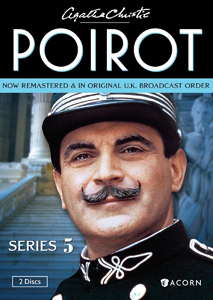Heading into Season 5 (1993, ITV), the writers of “Agatha Christie’s Poirot” had eight more short stories to adapt (not counting the linked stories from “The Labors of Hercules” and stories expanded into novels). In Season 6 and beyond, they’d adapt the remainder of the novels (and rework “Labors” into a single story).
Generally speaking, “Poirot” leaves the slightest of the short stories for last, meaning there’s room to expand on characters and add spicy side plots. The writers take wild swings, but are timid at other times. Christie’s plots sometimes get buried in the ephemera, so much so that Season 5 often uses recall flashbacks within single episodes to return our focus to the plots.
While certainly a watchable season thanks to the unmatched professionalism of David Suchet (as Poirot), Hugh Fraser (as Hastings), Pauline Moran (as Miss Lemon) and Philip Jackson (as Chief Inspector Japp), this is the shakiest in mystery plotting and overall quality so far. After seeing the team master novel adaptations in Season 4, I expect they’ll return to high standards in Season 6.

“Agatha Christie’s Poirot” Season 5 (1993)
ITV, eight episodes
Writers: Clive Exton, Bill Craig, Anthony Horowitz, Douglas Watkinson
Stars: David Suchet, Hugh Fraser, Pauline Moran, Philip Jackson
But first, here’s a look at Season 5, with links to my review of the U.S. collection the story comes from:
1. “The Adventure of the Italian Nobleman” (episode 5, written by Clive Exton)
I’m of two minds on this adaptation of a 1923 yarn. It’s delightful that Miss Lemon has a man interested in her, and that she is delighted by the attention. It strikes me as off-base that Hastings – usually with a fine-tuned radar for attractive women — would be flabbergasted by the idea of his colleague drawing romantic interest. And it ends with Miss Lemon being reaffirmed as a lonely cat lady – as established in the season premiere – which is reductive, although it’s partially for the closing gag of Poirot being annoyed that there’s a feline in his office. Overall, it’s a showcase for Moran, so the positives win out.
Story: “Poirot Investigates”
2. “Jewel Robbery at the Grand Metropolitan” (8, Anthony Horowitz)
Two strong elements stand out in this adaptation of a 1923 story. One, director Ken Grieve keeps cutting to an inside-a-drawer shot of the box with the jewels in it, mirroring our mind’s singular attention in this classic plot about pearls so heavily guarded they can’t possibly be stolen. Two, Celestine (Hermione Norris) – charged with guarding the valuables but inexplicably failing – has our and Poirot’s sympathy. Throw in shots of a play enjoyed by all four of our leads, and “Poirot” respectably wraps its short-story period.

Story: “Poirot Investigates”
3. “The Chocolate Box” (6, Douglas Watkinson)
Suchet is magnificent in this 1923 adaptation as he sheds the padded suit and – along with hair and mustache adjustments – looks decades younger, which is crucial for this story. Part of the plot takes place in the past (in Belgium), part in the present. Watkinson adds a “one that got away” love story, and Suchet has much better chemistry with Anna Chancellor (as Virginie) than with the countess in the Season 3 “star-crossed lovers” tale. I don’t always like wistfulness to intrude upon my comfort viewing, but I can’t deny it is crisply executed.
Story: “Poirot Investigates”
4. “Dead Man’s Mirror” (7, Horowitz)
An exception to the rest of the season, this one comes from a meaty novella (1937, expanded from 1932’s “The Second Gong”). Except for this episode coming out four months before “Jurassic Park,” I would’ve sworn composer Christopher Gunning had just watched that film, especially when Poirot’s car enters the mansion’s gates to trembling bass strains. It’s fun to work through gunshot angles and explanations behind multiple gong strikes. The conclusion is utterly gonzo, though not to the point of ruination. Poirot sets up a suspect to reveal herself, and she does so in the most over-the-top way, trying to coerce another supernaturally inclined suspect into taking the blame with “Scooby Doo” voice and lighting tricks.
Novella: “Dead Man’s Mirror”
5. “The Yellow Iris” (3, Horowitz)
The expanded novel, “Sparkling Cyanide” (1945), is naturally meatier than the 1937 short story, which “Poirot” no doubt chose to adapt since Colonel Race displaces Poirot in the novel. Featuring beautiful women in stylish dresses at two glamorous (and suspenseful) dinners, it’s a nice-looking hour. Horowitz’s decision to throw Poirot – persecuted for being a French-speaker — into the clutches of evil Argentinians allows for the past-and-present nature of the repeated dinner scenes, but it’s tonally jarring. The reveal of the killer – who “hides” simply by posing as a waiter (but without any disguise of his face) – is laugh-out-loud unbelievable.
Story: “The Regatta Mystery and Other Stories”
6. “The Adventure of the Egyptian Tomb” (1, Exton)
I like the cheeky aspect of Christie’s 1923 story wherein Poirot uses the villain’s credulity for the supernatural against him. It’s a relatively light story that previews Poirot’s more substantial jaunts to Middle Eastern archaeological digs and tourist sites (namely 1936’s “Murder in Mesopotamia”). The series of deaths are notably grisly on screen, like a not-quite-scary horror movie. Poirot (as averse to sand as Anakin Skywalker) and Hastings get buried in the drifts, becoming observers to a whodunit where really only one person could’ve done it.
Story: “Poirot Investigates”
7. “The Underdog” (2, Bill Craig)
Before her most famous “everyone has a motive” mystery, “Murder on the Orient Express” (1934), Christie toyed with the concept in a 1926 yarn. Business magnate Reuben Astwell (perfectly embodied by Denis Lill) is so despicable toward his family and employees that everyone is a suspect in his murder. He aims to sell an advanced rubber product – stolen from a former employee – to the Nazis! I was openly rooting for Poirot to go extrajudicial and let the killer off the hook. It’s almost impossible to guess the killer amid the mountain of suspects and misleading clues.
Story: “The Under Dog and Other Stories”
8. “The Case of the Missing Will” (4, Watkinson)
Taking Christie’s 1923 story about a will wherein a daughter is treated less favorably than the sons (because of the man’s belief that she will marry into money), Watkinson runs with it – right off the rails – with a blunt lecture piece on gender equality. Sure, it’s something most viewers – and Poirot himself – agree with, but the absence of nuance in the teleplay is staggering to the point where we can barely focus on the mystery.
Story: “Poirot Investigates”
IMDb Top 250 trivia
- “Poirot” stands at No. 149 in the IMDb TV rankings, with an 8.6 rating.
- The season’s top-rated episode is “The Chocolate Box” (8.2), and the bottom-rated episode is “The Underdog” (7.3).

